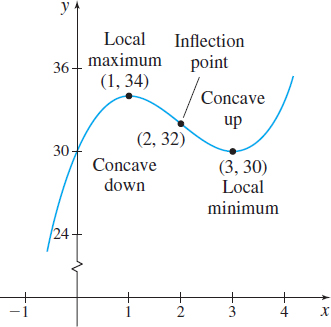EXAMPLE 5Finding Local Extrema and Determining Concavity
- (a) Find any local extrema of the function f(x)=x3−6x2+9x+30.
- (b) Determine where f(x)=x3−6x2+9x+30 is concave up and where it is concave down.
Solution (a) The first derivative of f is f′(x)=3x2−12x+9=3(x−1)(x−3)
So, 1 and 3 are critical numbers of f. Now,

Figure 40  f(x)=x3−6x2+9x+30
f(x)=x3−6x2+9x+30
So f is increasing on (−∞,1) and on (3,∞); f is decreasing on (1,3).
At 1, f has a local maximum, and at 3, f has a local minimum. The local maximum value is f(1)=34; the local minimum value is f(3)=30.
(b) To determine concavity, we use the second derivative: f′′(x)=6x−12=6(x−2)
Now, we solve the inequalities f′′(x)<0 and f′′(x)>0 and use the Test for Concavity.

